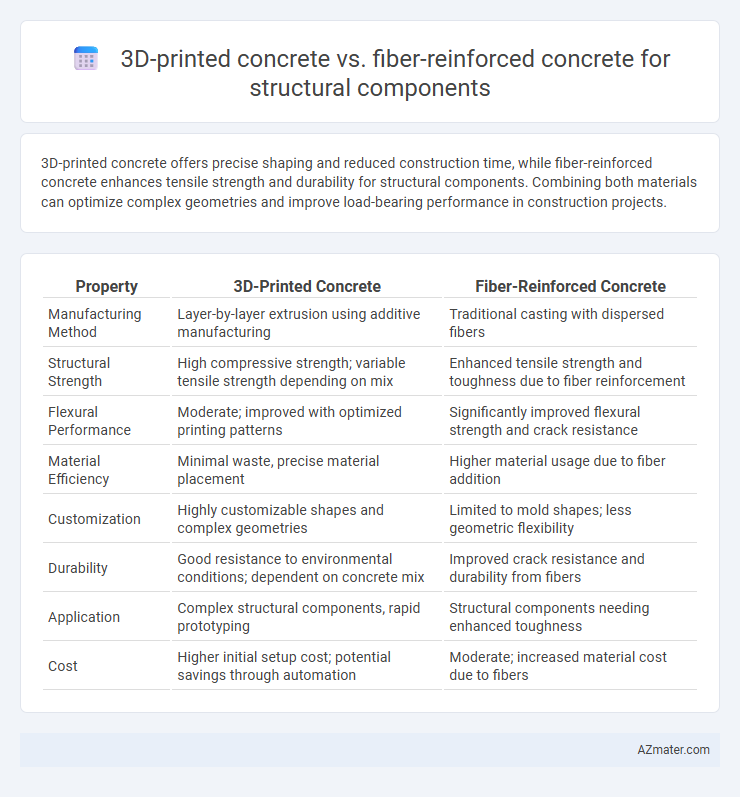3D-printed concrete offers precise shaping and reduced construction time, while fiber-reinforced concrete enhances tensile strength and durability for structural components. Combining both materials can optimize complex geometries and improve load-bearing performance in construction projects.
Table of Comparison
| Property | 3D-Printed Concrete | Fiber-Reinforced Concrete |
|---|---|---|
| Manufacturing Method | Layer-by-layer extrusion using additive manufacturing | Traditional casting with dispersed fibers |
| Structural Strength | High compressive strength; variable tensile strength depending on mix | Enhanced tensile strength and toughness due to fiber reinforcement |
| Flexural Performance | Moderate; improved with optimized printing patterns | Significantly improved flexural strength and crack resistance |
| Material Efficiency | Minimal waste, precise material placement | Higher material usage due to fiber addition |
| Customization | Highly customizable shapes and complex geometries | Limited to mold shapes; less geometric flexibility |
| Durability | Good resistance to environmental conditions; dependent on concrete mix | Improved crack resistance and durability from fibers |
| Application | Complex structural components, rapid prototyping | Structural components needing enhanced toughness |
| Cost | Higher initial setup cost; potential savings through automation | Moderate; increased material cost due to fibers |
Introduction to 3D-Printed Concrete and Fiber-Reinforced Concrete
3D-printed concrete is an innovative construction technology that uses additive manufacturing to build complex structural components layer by layer, offering enhanced design flexibility and reduced material waste. Fiber-reinforced concrete incorporates discrete fibers, such as steel, glass, or synthetic fibers, to improve tensile strength, crack resistance, and durability of traditional concrete mixtures. Both materials represent advancements in concrete technology aiming to optimize structural performance, with 3D printing enabling customization and fiber reinforcement enhancing mechanical properties.
Material Composition: 3D-Printed vs Fiber-Reinforced Concrete
3D-printed concrete typically contains a highly flowable cementitious mixture with admixtures that optimize printability and setting time, often reinforced by fine aggregates and additives to enhance bonding between layers. Fiber-reinforced concrete incorporates synthetic or steel fibers uniformly dispersed within the matrix, significantly improving tensile strength, crack resistance, and ductility in structural components. The key distinction lies in 3D-printed concrete's layer-by-layer deposition requiring precise rheological control, while fiber-reinforced concrete relies on fiber dispersion for enhanced mechanical properties and durability.
Structural Performance Comparison
3D-printed concrete offers superior design flexibility and reduced material waste, but its layer-by-layer construction can lead to anisotropic mechanical properties, affecting structural performance under complex loading. Fiber-reinforced concrete enhances tensile strength, toughness, and crack resistance due to the uniform distribution of fibers, making it highly reliable for structural components subjected to dynamic stresses. Comparative studies indicate fiber-reinforced concrete generally provides higher ductility and energy absorption, whereas 3D-printed concrete is advancing rapidly with optimized mixes and reinforcement strategies to close the performance gap.
Durability and Longevity Analysis
3D-printed concrete offers precise layering and reduced material waste, but its durability largely depends on print quality and curing conditions, with potential for microstructural weaknesses affecting longevity. Fiber-reinforced concrete (FRC), enhanced with synthetic or steel fibers, exhibits superior crack resistance, toughness, and long-term durability, making it highly effective for structural components exposed to dynamic loads. Comparative studies reveal FRC's enhanced resistance to tensile stresses and environmental degradation, while 3D-printed concrete demands optimization in mix design and reinforcement techniques to match FRC's performance in structural durability.
Construction Speed and Efficiency
3D-printed concrete significantly accelerates construction speed by enabling layer-by-layer automation and reducing the need for formwork, making it ideal for rapid structural component fabrication. Fiber-reinforced concrete enhances structural performance and durability but typically involves longer curing times and more traditional, labor-intensive placement processes. Combining 3D printing with fiber reinforcement technology offers a promising solution to optimize both construction efficiency and material resilience in structural applications.
Design Flexibility and Architectural Possibilities
3D-printed concrete offers unparalleled design flexibility by enabling complex geometries and intricate architectural forms that traditional molds cannot achieve, reducing material waste and construction time. Fiber-reinforced concrete enhances structural performance by improving tensile strength and crack resistance but remains limited by conventional casting methods that restrict architectural creativity. Combining 3D printing technology with fiber reinforcement could revolutionize structural components by merging advanced mechanical properties with expansive design possibilities.
Sustainability and Environmental Impact
3D-printed concrete reduces material waste and energy consumption by using precise deposition techniques, significantly lowering the carbon footprint compared to traditional fiber-reinforced concrete. Fiber-reinforced concrete improves durability and crack resistance, extending structural lifespan, but often involves synthetic fibers with higher embodied energy. Sustainable construction favors 3D-printed concrete innovations that optimize resource efficiency while maintaining structural integrity.
Cost Analysis and Economic Viability
3D-printed concrete reduces labor costs and material waste through automation and precise layering, making it economically viable for complex structural components despite higher initial equipment investment. Fiber-reinforced concrete involves additional material costs due to synthetic or natural fibers but improves durability and reduces maintenance expenses over time. Overall, 3D-printed concrete offers better cost efficiency in custom, low-volume applications, while fiber-reinforced concrete remains cost-effective for conventional, large-scale projects.
Applications in Modern Structural Engineering
3D-printed concrete excels in creating complex, customized structural components with reduced material waste, making it ideal for innovative architectural designs and rapid prototyping in modern structural engineering. Fiber-reinforced concrete enhances durability and crack resistance, ensuring improved load-bearing capacity and longevity of structural elements such as beams, slabs, and columns. Both materials are revolutionizing construction by enabling advanced design flexibility and performance, with 3D-printed concrete focusing on form complexity and fiber-reinforced concrete optimizing structural strength.
Future Trends in Advanced Concrete Technologies
3D-printed concrete is revolutionizing structural component fabrication by enabling complex geometries and reducing material waste through additive manufacturing, while fiber-reinforced concrete enhances tensile strength and durability with improved crack resistance. Future trends indicate increased integration of nanomaterials and AI-driven design optimization in 3D printing processes, alongside the development of hybrid composites combining fibers with printable matrices for superior performance. Advances in sustainable binders and real-time monitoring technologies will further drive the adoption of these innovative concrete solutions in construction infrastructure.

Infographic: 3D-printed concrete vs Fiber-reinforced concrete for Structural component
 azmater.com
azmater.com